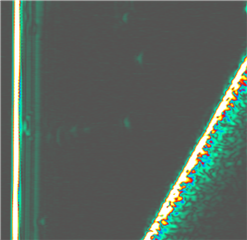Other Parts Discussed in Thread: AFE5808A, AFE5808
Ghost signals.
We use the AFE 5809 in a single element system. Using ch8.
We get a nice and clear image, but we also get some “ghost” echoes.
When scanning on an object in water (9 micron plastic film) we get a clear reflection and just behind the correct signal we get 2 – 4 extra signals. Not very strong signal, but none the less, unwanted signals. The signal is not saturated.


